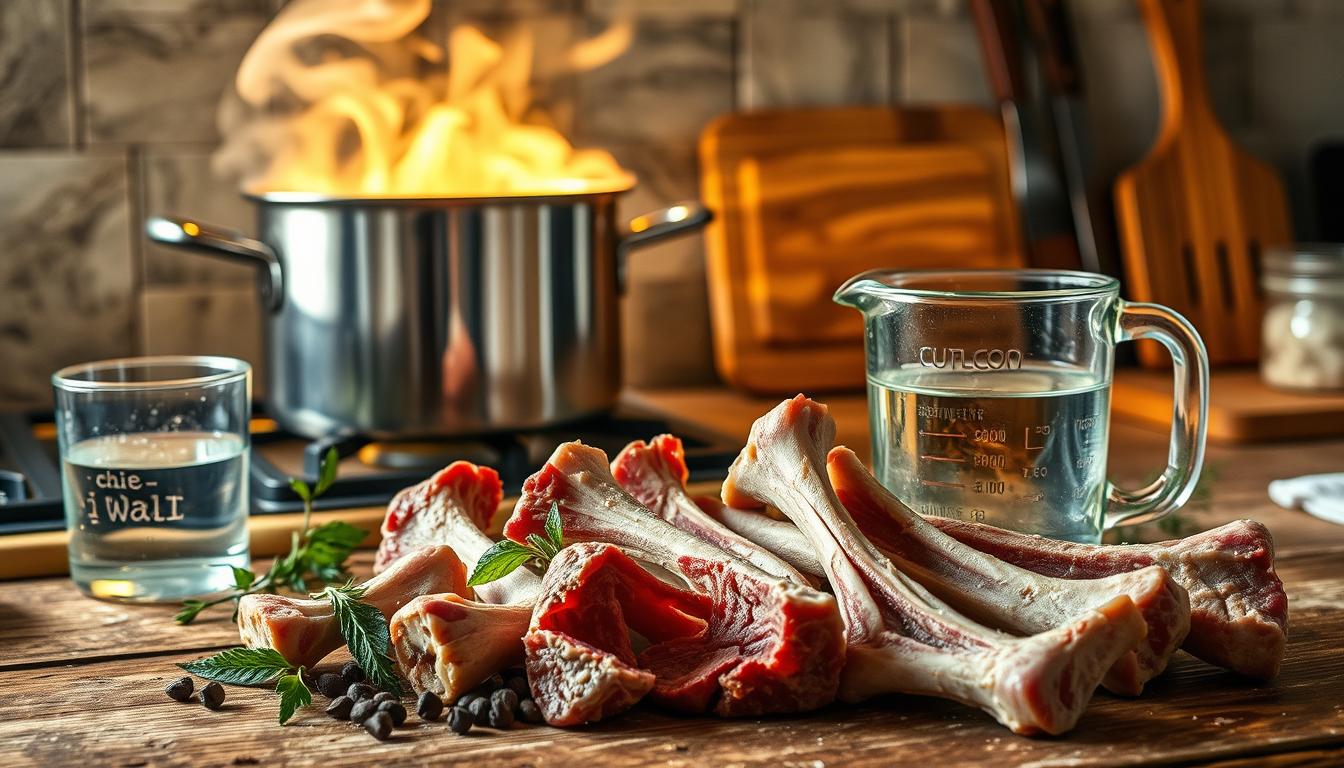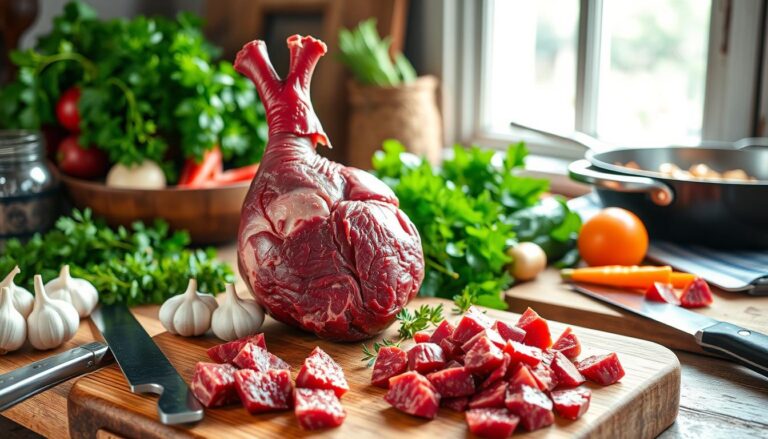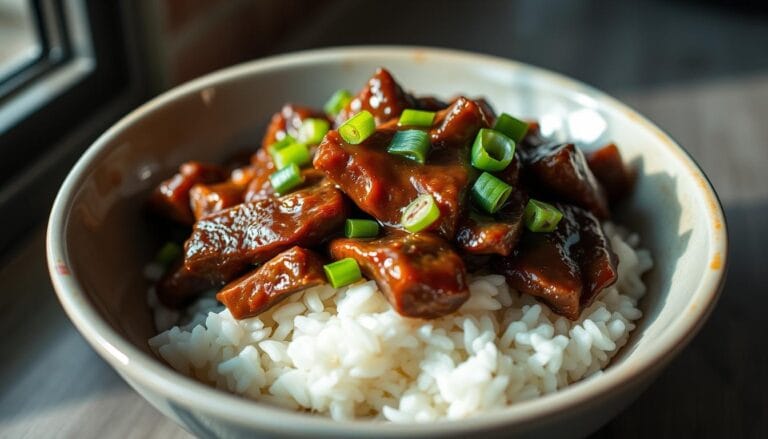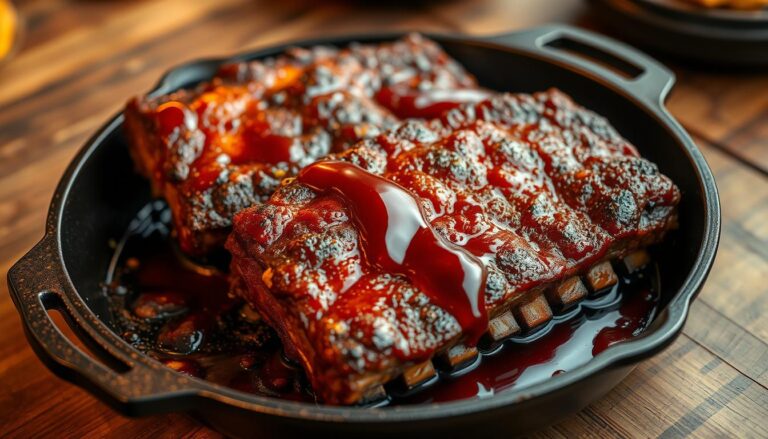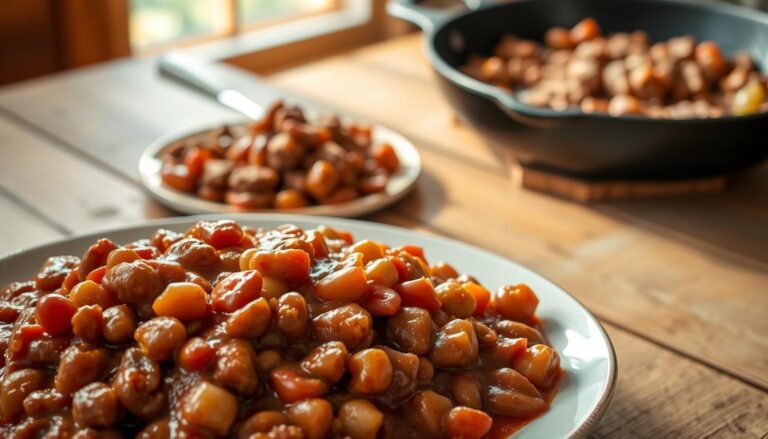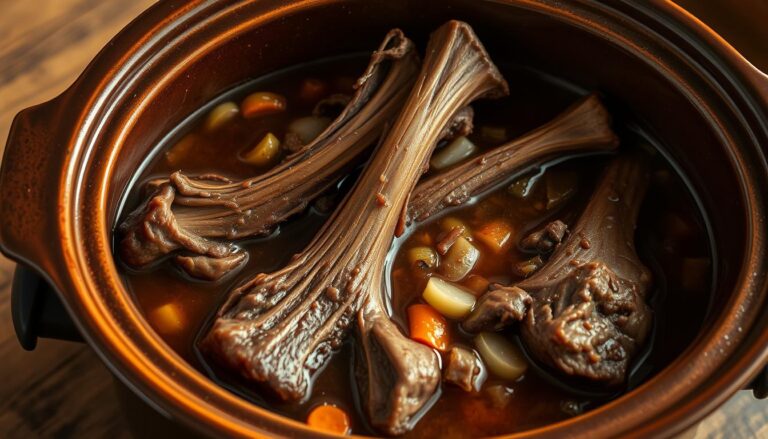How to Make Beef Bone Broth: A Simple Guide
Years ago, my grandmother’s kitchen always had a pot of beef bone broth simmering. It filled our home with a rich, comforting aroma. This aroma spoke of tradition and nourishment. Today, I’m excited to share the art of making beef bone broth.
Making beef bone broth is more than just a cooking technique. It’s a journey into wholesome nutrition. Whether you’re a health enthusiast or a home cook, this guide will help you. You’ll learn to create a delicious, nutrient-rich bone broth.
Beef bone broth has seen a remarkable revival in recent years. It’s celebrated for its incredible health benefits and deep, complex flavor. From supporting joint health to providing essential minerals, this humble broth is a nutritional powerhouse.
In this comprehensive guide, you’ll learn how to make beef bone broth that’s packed with flavor and nutrition. We’ll cover everything from selecting the right bones to mastering the perfect simmering technique. Get ready to unlock the secrets of creating a broth that will become a staple in your kitchen.
Table of Contents
What is Beef Bone Broth?
Beef bone broth has become a favorite among health lovers and cooks. It’s not just a simple stock. It’s a traditional food filled with amazing benefits.
Understanding Bone Broth Basics
Bone broth is different from regular cooking liquids. It extracts minerals and nutrients from animal bones. This happens when bones are simmered for 12-24 hours, releasing important compounds.
Nutritional Powerhouse Breakdown
Now, let’s look at the amazing nutrients in beef bone broth:
- Rich in essential minerals like calcium, magnesium, and phosphorus
- Contains collagen for joint and skin health
- Provides amino acids that support overall wellness
| Nutrient | Quantity per Cup | Key Benefits |
|---|---|---|
| Glycine | 500-1700 mg | Supports sleep quality |
| Calcium | 10-20 mg | Bone health |
| Phosphorus | 15-25 mg | Cellular repair |
“Bone broth is liquid nutrition – a healing elixir that connects us to traditional food wisdom.” – Culinary Nutritionist
Your body will thank you for adding beef bone broth to your diet. It boosts gut health, reduces inflammation, and is low in calories. You can make about 8 quarts at a time, making it a great addition to your meals.
Choosing the Right Bones
Creating a nutrient-rich organic beef bone broth starts with selecting the perfect bones. The bones you choose are key to a delicious and healthy broth.
Types of Bones for the Best Broth
Not all bones are created equal for making organic beef bone broth. The most nutritious options include:
- Knuckle bones: Rich in collagen
- Joint bones: Packed with connective tissues
- Marrow bones: Provide deep, complex flavor
- Beef feet: Excellent for gelatin content
“The quality of your bones determines the nutritional density of your broth.” – Bone Broth Experts
Sourcing High-Quality Beef Bones
When looking for the best bones for your organic beef bone broth, consider these top sources:
- Local farmers’ markets
- Grass-fed beef ranches
- Specialty butcher shops
- Online organic meat suppliers
Grass-fed and finished beef bones offer superior nutritional profiles. They have more omega-3 fatty acids and essential minerals than conventionally raised cattle.
Pro tip: Always ask about the sourcing and processing of the bones. Look for organic certification and pasture-raised options to ensure the highest quality for your organic beef bone broth.
Essential Ingredients for Bone Broth
Making delicious homemade beef bone broth is more than just bones. The right mix of vegetables, herbs, and spices makes a big difference. Let’s look at the key ingredients that will make your bone broth stand out.
Aromatic Vegetables That Make a Difference
The base of a rich homemade beef bone broth starts with classic aromatic vegetables. These add depth and complexity:
- Carrots: Bring natural sweetness and vibrant color
- Onions: Provide a robust, savory base
- Celery: Adds subtle earthy undertones
- Garlic: Delivers intense flavor and health benefits
Spices and Herbs for Maximum Flavor
Choosing the right herbs and spices can turn your homemade beef bone broth into a masterpiece. Here are some flavor enhancers:
- Bay leaves: Provide a subtle, complex aroma
- Black peppercorns: Add warm, spicy notes
- Fresh thyme: Introduces an earthy, herbal touch
- Apple cider vinegar: Helps extract minerals from bones
“The secret to an incredible bone broth lies in the quality of ingredients and the patience to let flavors develop.” – Culinary Nutrition Expert
When making your homemade beef bone broth, use 4-6 cups of vegetable scraps for better flavor. A splash of apple cider vinegar helps pull out minerals from the bones during cooking.
Equipment Needed for Making Broth
To make the best beef bone broth, you need the right tools. The cooking method you choose affects the broth’s taste and health benefits.
Choosing Your Cooking Method
There are three main ways to cook beef bone broth:
- Slow Cooker: Great for easy, long cooking
- Stovetop: Offers direct temperature control
- Pressure Cooker: Cuts cooking time in half
Essential Tools for Broth Making
For top-notch beef bone broth, you’ll need a few important items:
- Large Stock Pot: Should be at least 8 quarts
- Fine-mesh Strainer: For getting rid of bones and veggies
- Storage Containers: Use glass jars or BPA-free plastic
- Heavy-duty Tongs: Safe for handling hot bones
- Ladle: Handy for pouring hot broth
“The right equipment turns bone broth into a culinary masterpiece.” – Culinary Nutrition Expert
Comparing Cooking Methods
Each cooking method has its own benefits for your beef bone broth. Slow cookers keep a steady low heat, stovetop cooking lets you control it, and pressure cookers cut cooking time to 2-3 hours.
Your choice depends on your schedule, kitchen, and what you like. No matter the method, the right tools make a broth that’s full of flavor and nutrients.
Step-by-Step Recipe for Beef Bone Broth
Making delicious beef bone broth takes patience and care. Learning to make it at home can change your cooking. It also gives you a rich base for many dishes.
Preparing the Bones
First, pick high-quality beef bones. You need 3-4 pounds of meaty bones for the best broth. Roasting the bones is key to better flavor:
- Preheat your oven to 450 degrees Fahrenheit
- Arrange 10 beef marrow bone discs on a baking sheet
- Roast bones for 1 hour, turning occasionally
Cooking Process and Timing
Put the roasted bones in a 6-quart slow cooker. Add these ingredients to boost flavor:
- 2 medium white onions, chopped
- 1 whole garlic head
- 2 bay leaves
- 2 tablespoons apple cider vinegar
- 8 cups of water
“The secret to a rich beef bone broth is low and slow cooking.”
Skimming and Straining
Cook the broth on low for 12 hours. Skim off foam that forms on top. This makes the broth clearer and cleaner.
Strain the broth through a fine-mesh strainer after cooking. You’ll get about 96 ounces of healthy liquid. Store it in 3 large mason jars.
Pro tip: Leave an inch of space at the top of each jar when freezing to allow for expansion.
Tips for Enhancing Flavor
Improving the taste of your beef bone broth makes it more than just a drink. It turns it into a delicious experience. By adding special flavors, you can make your bone broth more complex and tasty.
Adding Acidity with Vinegar
Apple cider vinegar is key in making beef bone broth. It does more than just add flavor. It also pulls out important minerals from the bones while cooking. Just 1-2 tablespoons per batch can boost your broth’s health benefits.
- Use organic, unfiltered apple cider vinegar
- Add vinegar at the beginning of the cooking process
- Let bones sit in vinegar for 30 minutes before heating
Experimenting with Seasonings
Your beef bone broth is a blank canvas for your creativity. Different herbs and spices can change its taste, making each batch special.
| Herb/Spice | Flavor Profile | Best Used With |
|---|---|---|
| Rosemary | Earthy, pine-like | Beef, root vegetables |
| Turmeric | Warm, slightly bitter | Chicken, vegetables |
| Ginger | Spicy, aromatic | Seafood, Asian-inspired dishes |
Pro tip: Add fresh herbs in the last 10-15 minutes of cooking to preserve their vibrant flavors and nutritional benefits.
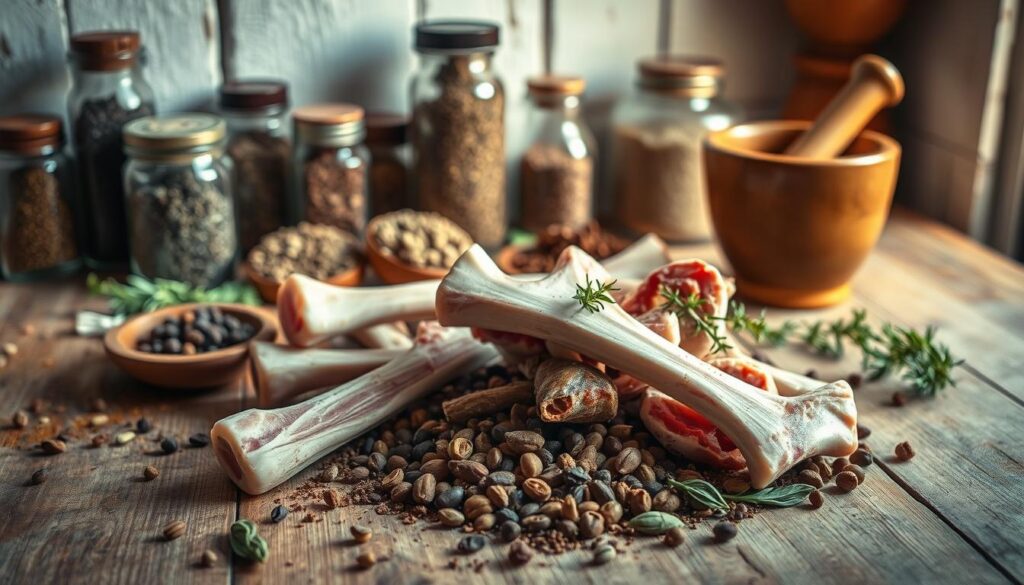
When trying out different seasonings for beef bone broth, start with a little. Adjust to your liking. A bit of sea salt can really enhance the taste. Healthy fats like coconut oil can add richness and depth.
How to Store and Preserve Bone Broth
Keeping your homemade beef bone broth fresh is key. It lets you enjoy its taste and health benefits for months. The right storage keeps your broth safe and top quality.
Refrigeration and Freezing Techniques
Storing your beef bone broth right is crucial. Here are the main ways to keep it fresh:
- Refrigeration: Store broth in airtight containers for up to 5-7 days
- Freezing: Extends preservation for 4-6 months
- Pressure canning: Provides longest shelf-stable storage
Freezing Best Practices
Freezing your beef bone broth? Follow these important tips:
- Cool broth to room temperature before storing
- Leave 1-inch headspace in containers to allow expansion
- Use freezer-safe containers like:
| Container Type | Capacity | Best For |
|---|---|---|
| Wide-mouth Mason Jars | Pint/Half-Pint | Small Portions |
| Freezer Bags | Quart/Gallon | Bulk Storage |
| Ice Cube Trays | 2-4 oz | Quick Recipe Additions |
Pro Storage Tips
Want your bone broth to stay great? Here’s how:
- Avoid adding salt before freezing
- Label containers with date and contents
- Store in coldest part of freezer
“Proper storage transforms your bone broth from a simple kitchen project into a nutritious, long-lasting pantry staple.”
By using these storage tips, you’ll keep your homemade beef bone broth tasty and full of nutrients. Enjoy healthy meals for months to come.
Creative Ways to Use Beef Bone Broth
Beef bone broth is more than just a drink. It’s a culinary powerhouse that can change your cooking. It adds deep flavor and nutrients to your meals.
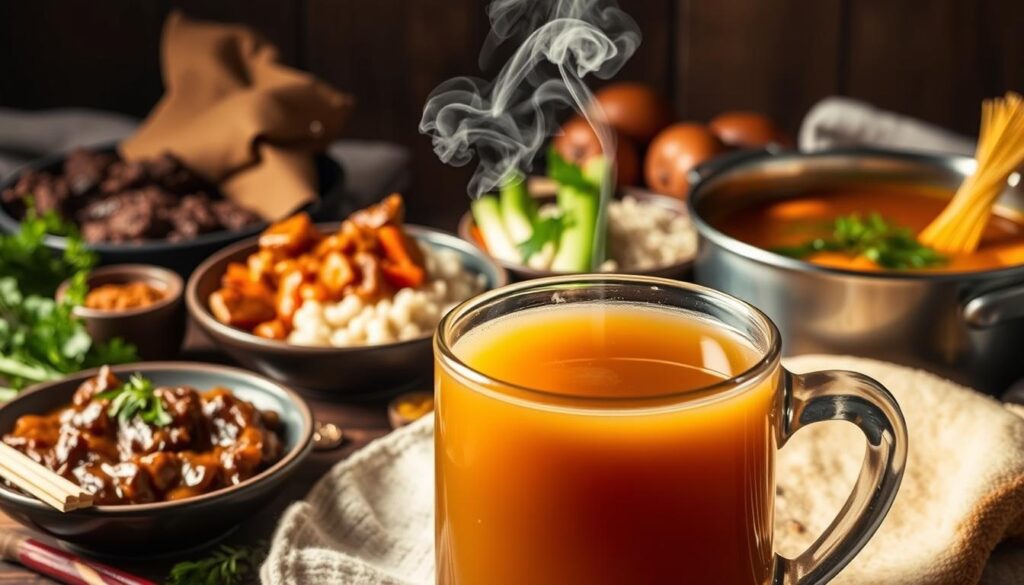
Your homemade beef bone broth is super flexible in the kitchen. Let’s look at some fun ways to use it in your daily meals.
Soups and Stews: A Flavor Revolution
Beef bone broth makes soups and stews amazing. It turns simple dishes into something special. Here’s how:
- Use bone broth instead of water in soup recipes
- Get rich, complex flavors
- Make your comfort foods healthier
Cooking Grains and Vegetables with Depth
Cooking grains and veggies in beef bone broth is a game-changer. It adds incredible taste and extra nutrients to your dishes.
- Cook rice or quinoa in bone broth for a twist
- Sauté veggies with bone broth for extra flavor
- Make your side dishes more tasty and healthy
“A cup of bone broth can be your daily meditation of nourishment.” – Culinary Wellness Expert
Pro tip: Start with a little bone broth when trying new recipes. It helps you adjust flavors and find your favorite ways to cook.
Common Mistakes to Avoid
Making the best beef bone broth needs careful attention and avoiding common mistakes. These errors can greatly affect the taste and health benefits of your broth.
To make an outstanding beef bone broth, it’s important to know and avoid key mistakes. Here are the main errors to steer clear of:
Overcooking the Bones
One big mistake is overcooking the bones. Cooking them for more than 16-18 hours can make the broth taste bitter. It’s best to cook at 98 degrees Celsius. This temperature helps get the most collagen and nutrients without ruining the broth.
Skipping the Sauté Step
Not sautéing your vegetables before adding them is another big mistake. Roasting bones and veggies adds a rich flavor. Here’s how to avoid this:
- Roast bones at 375°F for 30-60 minutes
- Sauté vegetables before adding to the broth
- Use a minimal mixture of bones, vegetables, and herbs
Additional Mistakes to Watch For
- Not skimming impurities during the first 20 minutes of cooking
- Failing to maintain proper bone-to-water ratio (1:2 for beef bones)
- Overlooking the importance of chilling the broth quickly to prevent bacterial growth
“Perfecting your beef bone broth is an art that requires patience and attention to detail.” – Culinary Experts
Avoiding these common mistakes will help you make a delicious, healthy beef bone broth. It will be a standout in your cooking collection.
Health Considerations and Precautions
Beef bone broth is great for health, but knowing dietary limits is key. Your health affects how it benefits you. It has a lot of sodium and minerals, so some need to be careful.
Those with kidney disease should watch out because of the broth’s potassium and sodium. A typical store-bought broth has 350 milligrams of sodium, which is 15% of what you should have daily. People with blood pressure issues or certain health problems should check labels and might need to drink less.
Dietary Restrictions to Keep in Mind
Beef bone broth’s benefits can differ for everyone. If you have autoimmune diseases, digestive issues, or special diets, talk to a doctor first. Some might react to it or need special amounts.
Consulting a Healthcare Professional
Getting advice from a doctor is important for safe bone broth use. Talk to a dietitian or doctor about your health goals, any medication issues, and what you need nutritionally. This way, you can enjoy the benefits of beef bone broth safely.
FAQ
What is beef bone broth and how is it different from regular stock?
How do I choose the best bones for making beef bone broth?
How long should I cook beef bone broth?
Can I make beef bone broth if I’m on a special diet?
How should I store homemade beef bone broth?
What are the primary health benefits of beef bone broth?
Can I drink beef bone broth by itself?
What equipment do I need to make beef bone broth?
Did You Try This Recipe ?
There are no reviews yet. Be the first one to write one.

